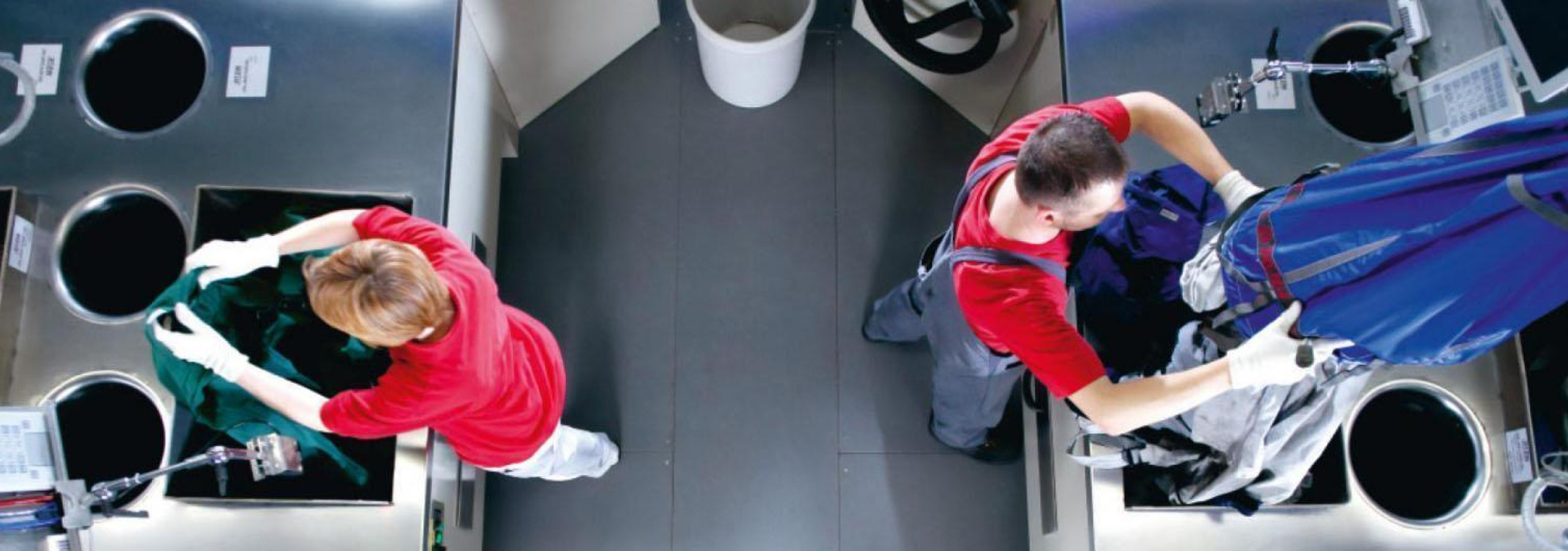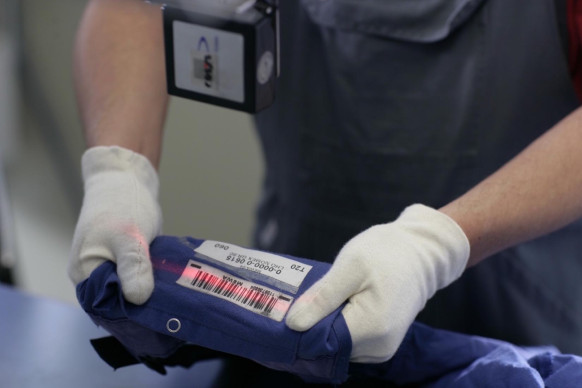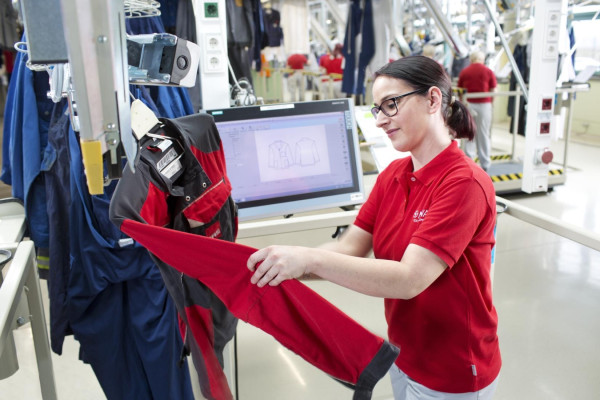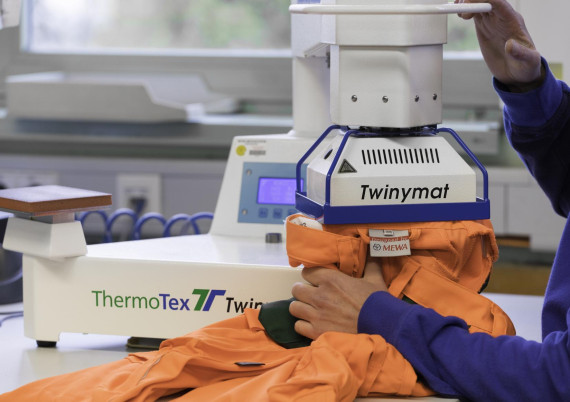

Hanger for hanger, trousers, jackets, blouses, polo-shirts and shirts from a seemingly endless conga line. The line moves along kilometre-long belts to the first floor, where countless items of clothing are already waiting to be processed. Another floor up, it’s the same picture. At Mewa in Meißenheim, laundering is on a grand scale … The textile service provider takes on responsibility for the work clothes of more than 6400 customers from all over Baden-Württemberg and Alsace as well as parts of Switzerland. The textiles are provided and collected after wear, washed, finished, maintained, repaired, replaced when worn out and finally dispatched. To the locker or the laundry cupboard of the respective employee, depending on the customer. 420,000 items of clothing from 130,000 users go through the procedure every month, from collection at the company to dispatch by Mewa’s own service drivers. “As well as the expertise of our 320 employees, we depend on process quality and an IT-supported identification system with THERMOTEX products to make sure that every item ends up at the right address”, says Anton Hardt. Together with Philippe Julien as commercial manager, the technical managing director has formed the two-man head of Mewa Textil-Service AG & Co. OHG in Meißenheim for three years. Behind the door with its friendly but clear instruction of “Please disinfect your hands”, it smells like clean laundry. No wonder: Everything that hangs here from the branched track system already has its wash and drying cycle behind it. All textiles are also registered - thanks to scanners and THERMOTEX. Every item of clothing is equipped with a barcode that assigns it to a certain person - and thus to one customer, location and certain service or criteria catalogue.
Tailored care for each item
Two washing lines and several tumblers are the engine of the Mewa plant. They ensure a constant stream of clean laundry on the route through the company. The fi rst step is collection from the customer and the subsequent, in Meißenheim, sorting according to quality and colour to determine the wash cycle and corresponding detergent dosage. The Mewa location in the Kürzell district of Meißenheim is one of the largest in the group. Altogether, there are 44 branches that provide companies with work and protective clothing, cleaning cloths, oil cloths and dust mats as well as component cleaners in a full service. Around 5200 employees take care of more than 180,000 customers from industry, trade, handwork and gastronomy throughout Europe. Even though around 335 tonnes of textiles are washed at the 44 branches on a daily basis, the focus is on quality rather than quantity. “The customers that we serve from our location in Meißenheim include large corporations as well as medium-sized businesses. But we also have one-man operations that depend on us”, says Hardt. Their textiles take the same route as those from large automobile companies and their suppliers from Rastatt or Stuttgart, food discounters or construction groups. 
Barcodes for every single piece
After washing, the textiles, identifi ed by barcode and scanner, are hung on hangers that are equipped with a chip, and are as such married together: Hanger and textile now form an organisational unit. Afterwards, the hangers are taken by track system to control, where experts check the textiles against individual criteria catalogues to decide on their further progress. “Work clothes must not only be clean and in good condition, but may also be required to fulfi l certain norms”, explains Hardt. Personal protective equipment, for example, is subject to requirements regarding visibility or colour intensity. The clothing items remain in the regular cycle only when they fulfi l the criteria 100%. In all other cases, we “take action”. If the trousers, jacket or shirt fulfi l the required criteria, the hanger travels into one of the interim stores on the fi rst or second fl oor. If defects are discovered during the inspection, the switches of the track system are set so that this hanger goes to the sewing room. The item is received by the experts there, and they either repair it or decide that it must be replaced. Once the appropriate item of clothing is found for exchange in the right colour, quality and size, or arrives having been ordered in, it is personalised. Eight workspaces are responsible alone for the identifi cation of clothing using THERMOTEX processes. “We create heat seal strips using the TT4-S printer that contain a barcode with all data relevant for us. The name of the wearer can also be read in normal writing”, explains Hardt. This strip is then inseparably joined, or “married”, to the respective clothing item using the Twinymat pneumatic heat sealing machine. This labelling of the items of clothing takes only a few seconds. In well-practiced actions, trousers, jackets, etc. are laid properly on the heat sealing station, the patch laid on, and the upper sealing head lowered with pneumatic support. Attached to a hanger, the item of clothing then sets off again on its usual path through the hall with the other textiles.
The whole process as well as the delivery of the ready clothes to the customer by the service driver takes place at an interval individually arranged with the customer. In the wash cycle, the putting together of the respective delivery in particular requires time and space. By means of a sophisticated process and a track system that wouldn’t be out of place in a freight-handling train station, the thousands of clothing items are assigned to a wearer and placed together in a lot with those of the same customer. 
Guiding principle: environmental protection
There’s a quiet rattling. Above the heads of the employees in quality control, a long row or textiles including hangers has set off on its way. Some go off to the right, some to the left. Some go up and others are parked, just to set off again like at a shunting yard. After several rounds, the hangers are sorted and automatic grouping is the goal. At the end, clothes sacks and laundry cars are waiting for textiles and service drivers. “But our responsibility goes further”, says Hardt. The conscious handling of resources is part of Mewa’s guiding principle. Modern washing processes as well as dosing and management systems help to conserve water, energy and detergents. In addition, Mewa uses its own self-developed system for reusing water from the washing and rinsing cycles, which saves up to 50 % of fresh water.